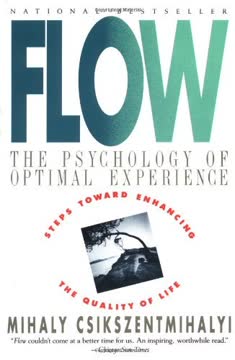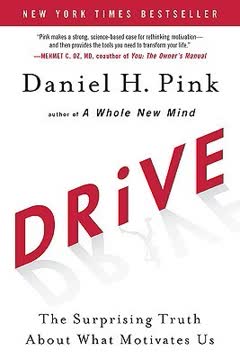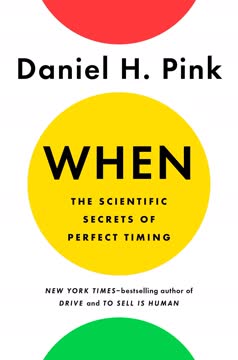Key Takeaways
1. Intrinsic motivation trumps extrinsic rewards
"The joy of the task was its own reward."
Internal drive matters. Traditional motivational theory assumes that rewarding good behavior and punishing bad behavior produces the best results. However, Daniel Pink's research reveals that for tasks requiring cognitive skills, intrinsic motivation is far more effective. This internal drive comes from the inherent satisfaction of the work itself, rather than external carrots or sticks.
Psychological needs. Pink identifies three key psychological needs that, when satisfied, lead to heightened motivation, productivity, and happiness:
- Competence: The desire to master skills and grow
- Autonomy: The freedom to direct one's own life and work
- Relatedness: The need to connect with others and contribute to something larger
By fostering environments that nurture these intrinsic motivators, organizations can tap into people's natural inclination to learn, create, and achieve.
2. Autonomy fuels engagement and creativity
"The ultimate freedom for creative groups is the freedom to experiment with new ideas."
Self-direction breeds innovation. Autonomy is about giving employees control over various aspects of their work:
- Task: What they do
- Time: When they do it
- Team: Who they do it with
- Technique: How they do it
Empowerment yields results. Companies that grant workers more autonomy often see increased engagement, productivity, and innovation. For example:
- Google's "20% time" policy, allowing engineers to spend a fifth of their time on self-directed projects, led to the creation of Gmail and AdSense
- Atlassian's "FedEx Days," where employees work on anything they want for 24 hours, have resulted in numerous product improvements
By trusting employees and giving them freedom, organizations can unlock creativity and drive that traditional management approaches often stifle.
3. Mastery is a powerful drive for personal growth
"Mediocrity is expensive while excellence can be the antidote."
The urge to improve. Mastery is the desire to get better at something that matters. This drive is a powerful motivator, pushing people to continually develop their skills and knowledge. It explains why people engage in challenging hobbies, pursue difficult careers, or spend countless hours perfecting their craft.
Flow and optimal challenges. To foster mastery:
- Provide "Goldilocks tasks": Neither too easy nor too hard
- Create opportunities for "flow" experiences, where skill and challenge are perfectly matched
- Emphasize progress and continuous improvement over fixed performance targets
Organizations that understand and harness the drive for mastery can create deeply engaged employees who are intrinsically motivated to excel and innovate.
4. Purpose connects work to a greater cause
"Greatness and nearsightedness are not compatible. Meaningful achievement is dependent on lifting someone else's sights and pushing them towards the horizon."
Beyond profit. Purpose is about connecting work to something larger than oneself. In an era where basic needs are met for many, people increasingly seek meaning in their work. Organizations that articulate and embody a clear, inspiring purpose can motivate employees far beyond what extrinsic rewards can achieve.
Aligning purpose with profit. Companies can foster purpose by:
- Clearly communicating how the organization's work positively impacts the world
- Allowing employees to see the direct impact of their work on customers or society
- Encouraging volunteer work and corporate social responsibility initiatives
- Ensuring that the company's actions align with its stated values and mission
When employees understand how their work contributes to a greater good, they're more likely to be engaged, committed, and motivated to perform at their best.
5. Rewards can harm complex, creative tasks
"Once the task called for 'even rudimentary cognitive skill,' a larger reward led to poorer performance."
The limits of "if-then" rewards. While extrinsic rewards can be effective for straightforward, mechanical tasks, they often backfire for complex, creative work. Pink cites research showing that higher incentives led to worse performance on tasks requiring cognitive skill.
The hidden costs of rewards:
- Narrow focus: Rewards can cause people to fixate on the incentivized behavior, ignoring other important aspects
- Short-term thinking: The pursuit of immediate rewards can lead to neglect of long-term goals
- Reduced intrinsic motivation: External rewards can diminish the inherent satisfaction derived from the task itself
For knowledge work and creative endeavors, organizations should focus on creating environments that foster intrinsic motivation rather than relying heavily on extrinsic incentives.
6. Money matters, but in a different way
"Pay people enough to take the issue of money off the table."
Fair compensation is crucial. Pink argues that money is still important, but its role in motivation is more nuanced than traditionally thought. Rather than using money as the primary motivator, organizations should:
- Ensure fair and adequate base compensation
- Remove pay as a source of anxiety or dissatisfaction
- Focus on other factors to drive engagement and performance
Beyond the paycheck. Once fair pay is established, other factors become more important for motivation:
- Recognition and appreciation
- Opportunities for growth and development
- Meaningful work and a sense of purpose
- Positive workplace relationships
By addressing compensation appropriately and then focusing on intrinsic motivators, organizations can create a more engaged and productive workforce.
7. Feedback is crucial for fostering progress
"The days when employees were most motivated to work are when they know that they are 'making progress in meaningful work.'"
The power of progress. Research shows that the single most important factor in motivating knowledge workers is a sense of progress. Regular feedback is essential for people to recognize their advancement and stay motivated.
Effective feedback strategies:
- Frequent: Provide feedback often, not just in annual reviews
- Specific: Offer concrete information about performance and areas for improvement
- Timely: Give feedback as close to the relevant work as possible
- Actionable: Focus on behaviors and outcomes that can be changed or improved
- Balanced: Recognize achievements while also addressing areas for growth
By implementing robust feedback systems, organizations can help employees see their progress, maintain motivation, and continually improve their performance.
8. Right-brain thinking is increasingly valuable
"Most jobs nowadays require the ability to be innovative, to be complex thinkers, and to think outside the box."
The rise of creative work. As routine tasks are increasingly automated, the most valuable skills in the modern economy involve creativity, empathy, and big-picture thinking—traditionally associated with right-brain functions.
Key right-brain abilities:
- Design: Creating aesthetically pleasing and functional products/experiences
- Story: Crafting compelling narratives to communicate ideas
- Symphony: Seeing the big picture and connecting disparate elements
- Empathy: Understanding and relating to others' emotions
- Play: Using humor and playfulness to innovate and solve problems
- Meaning: Finding purpose and significance in work and life
Organizations that cultivate these skills and create environments where they can flourish will be better positioned to innovate and succeed in the evolving economy.
9. Management must evolve beyond compliance
"Management was invented in the 1850s. It is a technology that was made to organize people into their productive capacities."
Beyond command and control. Traditional management approaches focused on compliance and control are ill-suited for motivating today's knowledge workers. Pink argues that management must evolve to:
- Foster autonomy rather than micromanage
- Facilitate mastery instead of dictating processes
- Connect work to purpose beyond profit
New management paradigms:
- Servant leadership: Focusing on supporting and empowering employees
- Results-Only Work Environments (ROWE): Judging performance by outcomes, not hours worked
- Self-managing teams: Giving groups autonomy to organize and execute their work
- Agile methodologies: Emphasizing flexibility, collaboration, and continuous improvement
By adopting more modern management approaches that align with intrinsic motivators, organizations can create more engaged, productive, and innovative workforces.
Last updated:
FAQ
What's "Drive: The Surprising Truth About What Motivates Us" by Daniel H. Pink about?
- Core Premise: The book explores what truly motivates people, challenging the traditional belief that rewards and punishments are the primary drivers of human behavior.
- Research-Based Insights: Daniel Pink draws on over 50 years of behavioral science research to present a new understanding of motivation.
- Focus on Intrinsic Motivation: Pink emphasizes the importance of intrinsic motivators like autonomy, mastery, and purpose over extrinsic rewards.
- Application in Modern Workplaces: The book provides insights into how businesses can adapt their motivational strategies to better engage employees in the 21st century.
Why should I read "Drive: The Surprising Truth About What Motivates Us"?
- Revolutionary Ideas: The book challenges conventional wisdom about motivation, offering fresh perspectives that can transform personal and professional life.
- Practical Applications: Pink provides actionable advice for managers and leaders to foster a more motivated and engaged workforce.
- Broad Appeal: Whether you're a business leader, educator, or individual seeking personal growth, the book offers valuable insights.
- Engaging Writing: Daniel Pink is praised for his engaging writing style, making complex ideas accessible and thought-provoking.
What are the key takeaways of "Drive: The Surprising Truth About What Motivates Us"?
- Autonomy, Mastery, Purpose: These are the three key intrinsic motivators that drive human behavior and performance.
- Limitations of Extrinsic Rewards: Traditional "if-then" rewards are effective for simple tasks but can hinder performance in complex, creative tasks.
- Fair Compensation: While money matters, it should be sufficient to take the issue off the table, allowing employees to focus on their work.
- Engagement Over Compliance: True engagement comes from giving employees more control and purpose in their work, not just managing them for compliance.
How does Daniel H. Pink define "Autonomy" in "Drive"?
- Control Over Work: Autonomy involves giving employees control over their tasks, time, team, and technique.
- Encourages Engagement: When employees have autonomy, they are more likely to be engaged and motivated.
- Beyond Traditional Management: Pink argues that traditional management techniques are outdated and do not foster autonomy.
- Practical Implementation: Businesses can implement autonomy by allowing flexible work hours, self-directed teams, and personal project choices.
What is "Mastery" according to "Drive" by Daniel H. Pink?
- Desire to Improve: Mastery is the inherent human drive to get better at something that matters.
- Continuous Learning: It involves a mindset of continuous improvement and learning.
- Feedback Importance: Frequent, informal feedback is crucial for fostering mastery, as it helps individuals recognize their progress.
- Challenges and Growth: Mastery requires challenges that are neither too easy nor too difficult, promoting growth and satisfaction.
How does "Drive" explain the concept of "Purpose"?
- Meaningful Work: Purpose is about doing work that has significance beyond oneself.
- Aligning Goals: Employees are more motivated when their personal goals align with the organization's mission.
- Impact on Performance: A strong sense of purpose can significantly enhance productivity and job satisfaction.
- Case Studies: Pink provides examples, such as call center employees who performed better when they understood the impact of their work.
What are "if-then motivators" in "Drive" by Daniel H. Pink?
- Definition: "If-then motivators" are traditional incentives where a reward is given if a specific task is completed.
- Effective for Simple Tasks: These motivators work well for tasks requiring mechanical skills.
- Limitations: They are less effective for tasks requiring creativity and cognitive skills, often leading to poorer performance.
- Need for New Strategies: Pink suggests that modern workplaces need to move beyond these motivators to engage employees effectively.
How does "Drive" challenge traditional motivational theories?
- Critique of Rewards and Punishments: Pink argues that the traditional carrot-and-stick approach is outdated and ineffective for complex tasks.
- Focus on Intrinsic Motivation: The book emphasizes intrinsic motivators as more powerful and sustainable.
- Research-Based Evidence: Pink supports his claims with extensive research and case studies.
- Call for Change: He advocates for a shift in how organizations motivate their employees, focusing on autonomy, mastery, and purpose.
What are some of the best quotes from "Drive" and what do they mean?
- "Mediocrity is expensive while autonomy can be the antidote." This quote highlights the cost of not fostering autonomy and the potential benefits of empowering employees.
- "The joy of the task was its own reward." This emphasizes the power of intrinsic motivation, where the satisfaction of doing the task itself is rewarding.
- "Meaningful achievement is dependent on lifting someone else's sights and pushing them towards the horizon." It underscores the importance of purpose and helping others achieve their potential.
How does "Drive" suggest businesses should adapt their motivational strategies?
- Embrace Autonomy: Allow employees more control over their work to increase engagement and satisfaction.
- Foster Mastery: Provide opportunities for continuous learning and improvement, with regular feedback.
- Cultivate Purpose: Align organizational goals with employees' personal values and show the impact of their work.
- Move Beyond Money: Ensure fair compensation but focus on intrinsic motivators for long-term performance.
What is the significance of the study involving call center employees in "Drive"?
- Purpose-Driven Performance: The study showed that employees who understood the purpose of their work performed significantly better.
- Impact of Purpose: Group 3, which was given a purpose, received more than double the donations compared to other groups.
- Practical Implications: This highlights the importance of communicating the significance of tasks to employees.
- Broader Lesson: Purpose can be a powerful motivator, leading to increased productivity and job satisfaction.
How does "Drive" by Daniel H. Pink relate to modern workplace challenges?
- Adapting to Change: The book addresses the shift from mechanical to cognitive tasks in the modern workplace.
- Need for New Motivators: It highlights the inadequacy of traditional motivators in today's complex work environments.
- Focus on Human Potential: Pink emphasizes unlocking human potential through intrinsic motivators.
- Guidance for Leaders: Provides actionable insights for leaders to create more engaging and productive work environments.
Review Summary
Drive explores how intrinsic motivation, rather than external rewards, drives human behavior and performance. Pink argues that autonomy, mastery, and purpose are key factors in motivation, challenging traditional carrot-and-stick approaches. The book resonates with many readers, who find its concepts applicable to various aspects of life and work. While some criticize its repetitiveness or lack of novelty, many praise its insights into human psychology and potential for improving workplace dynamics. Overall, Drive offers a thought-provoking perspective on motivation in the modern era.
Similar Books










Download PDF
Download EPUB
.epub digital book format is ideal for reading ebooks on phones, tablets, and e-readers.









